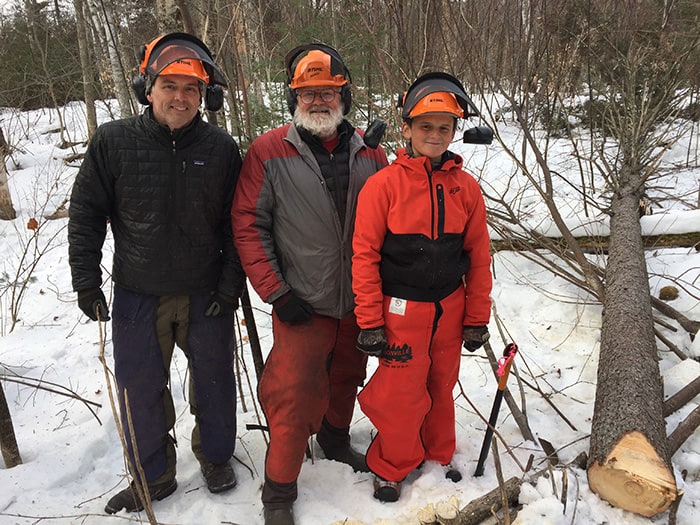
You’ll be outdoors for the day, so will want to dress accordingly, and in layers, and bring snacks and beverages to have available throughout the day.
* Discussion of and plan for Emergencies, and Personal Protective Equipment.
* Daily 5-Point Safety Check: Chain brake; throttle interlock; chain catcher; screws & bolt check; muffler and spark arrester.
* Discussion of Reactive Forces: Push; Pull; Kickback; Attack
* Notching: minimum of 70 degrees, no by-pass
* Bore Cutting: use attack corner, body position
* Felling Plan: Target acquisition of the 5-point felling plan
Target Acquisition: Hazard Recognition (2 points); Side Lean – good/bad side (2 points); Escape Route (2 points); Hinge Information (2 points); Back-cut Plan (2 points)
* Scoring the Stump
* Felling Practice
* Discussions of Routine Maintenance: Air filter; Recoil; Bar; Sprocket; Chain brake; Chain tension
* Carburator Tune-up: Clean air filter; Balance Jets; High-speed test; Low-speed test; Low-speed “dump” test
* Art of Filing – scoring the tooth: Proper depth gauge setting (2 points); Sharp Point (2 points); Correct side plate angle (2 points); Correct top plate angle (2 points); Chisel angle (2 points)
* Springpole Practice
* Felling Practice
* Scoring of Chain
* Dealing with Lean: Front Lean – use of the controlled release technique; Back Lean – use of wedges and shims; Side Lean – aiming the hinge to compensate for lean.
* Limbing Plan: Overhead hazards; Hazards on the ground; Did the tree leave stump?; Tensions in stem; Plan of attack
* Six-point Limbing Concepts: Keep close; Stem supports weight of saw; Move feet; Slide hand; Use thumb; Plan for working height
* Bucking and Limbing Cuts: Top-lock; Limb-lock; Tongue and groove
* Felling Difficult and Hung-Up trees
* Pre-planning: Information, use of maps; Reconnaissance
* Discussion on Flagging
* Selecting Felling Direction
* “Hot” vs “Cold” Logging
* Felling Exercise
* Course Review
This level is adjusted to the interest of the group, i.e. safely getting hung trees down, use of different tools. Drop-and-roll, lift-and-roll, scarf cut, pole-in-a-hole.
* Introduction and Review: Safety Plan; PPE; Daily 5-point Safety check; Saw Chain Types, sharpening and field conditions; Safety Violations
* 5-Point Plan for Storm Damaged Trees: Overhead Hazards; Hazards on the ground; Assess Lean-weight & pressure; Cutting plan; Escape Routes
* Demonstration and Hands-on Techniques: Shaved notch; Tab cut; Limb-loc; Top-loc; Tongue & groove; Axle-cut; Axle-loc; Notch bucking & Directional notch bucking (controlled release cut); Roll-away cut; Buck with wedge; Dirty log buck; Scissor cut; Releasing “extreme” spring-pole tension; “Pole-in-a-Hole”; Flagging hazards; Using Ropes & Mechanical Advantage Techniques
This course is designed to introduce the safe handling of a chainsaw, as well as boosting the confidence level of anyone who has very little or no experience with a saw. This is a hands-on full day course, and is an excellent foundation for someone who may go on to attend the Game of Logging Levels 1 through 4 training.
Safe techniques for working with trees under extreme compression/tension or damage due to wind-throw, ice damage, flooding, etc., where stems may be tangled, have root systems exposed, or other hazardous situations that need to be removed. Students must have completed GOL Levels 1-3 prior to attending this class. See description above.
USFS C-Sawyer Evaluators. As Certified Forest Service Training Consultants, we train Level 1 & 2 and evaluate for USFS certification.
NEWT works with Silvasuls, Inc. of Westport NY to provide Arborist Training incorporating GOL safety techniques. There are four levels of training available. Arborist training includes all aspects of safety and hazard identification, skills with ropes, knots, hitches, mechanical devices, equipment, and techniques and work practices for safe arborist work.
This training is designed to improve Logger safety, health, profit, and job quality.
A hands-on review of all techniques learned in Level 1 – 4. Participants must have completed all levels. Safety is an ongoing practice to keep skills and awareness sharp, and Game of Logging training should be renewed/refreshed every 5 years.
“Outstanding professional experience for adults and students. My class of high school forestry students learned the newest and safest way to work in the woods. The instruction is steeped in research, yielding highly valid methodology. It was also nice that the instructor did not convey the bravado and ego sometimes encountered in the timber industry. Rather he was open minded and well balanced on all issues.”
— Logger – COURSE: GOL Level 1